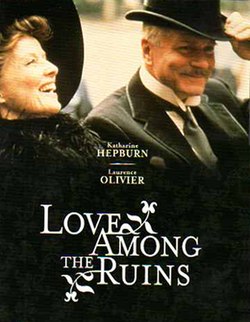| Love Among the Ruins | |
|---|---|
 DVD cover | |
| Genre |
|
| Written by | James Costigan |
| Directed by | George Cukor |
| Starring | Katharine Hepburn Laurence Olivier |
| Music by | John Barry |
| Country of origin | United States [1] |
| Original language | English |
| Production | |
| Producer | Allan Davis |
| Production locations | St. Pancras Station, St. Pancras, London, England Pinewood Studios, Iver Heath, Buckinghamshire, England |
| Cinematography | Douglas Slocombe |
| Editor | John F. Burnett |
| Running time | 103 minutes |
| Production company | ABC Circle Films |
| Original release | |
| Network | ABC |
| Release | March 6, 1975 |
Love Among the Ruins is a 1975 American made-for-television romantic comedy film directed by George Cukor and starring Katharine Hepburn and Laurence Olivier that premiered on ABC on March 6, 1975. [2]
